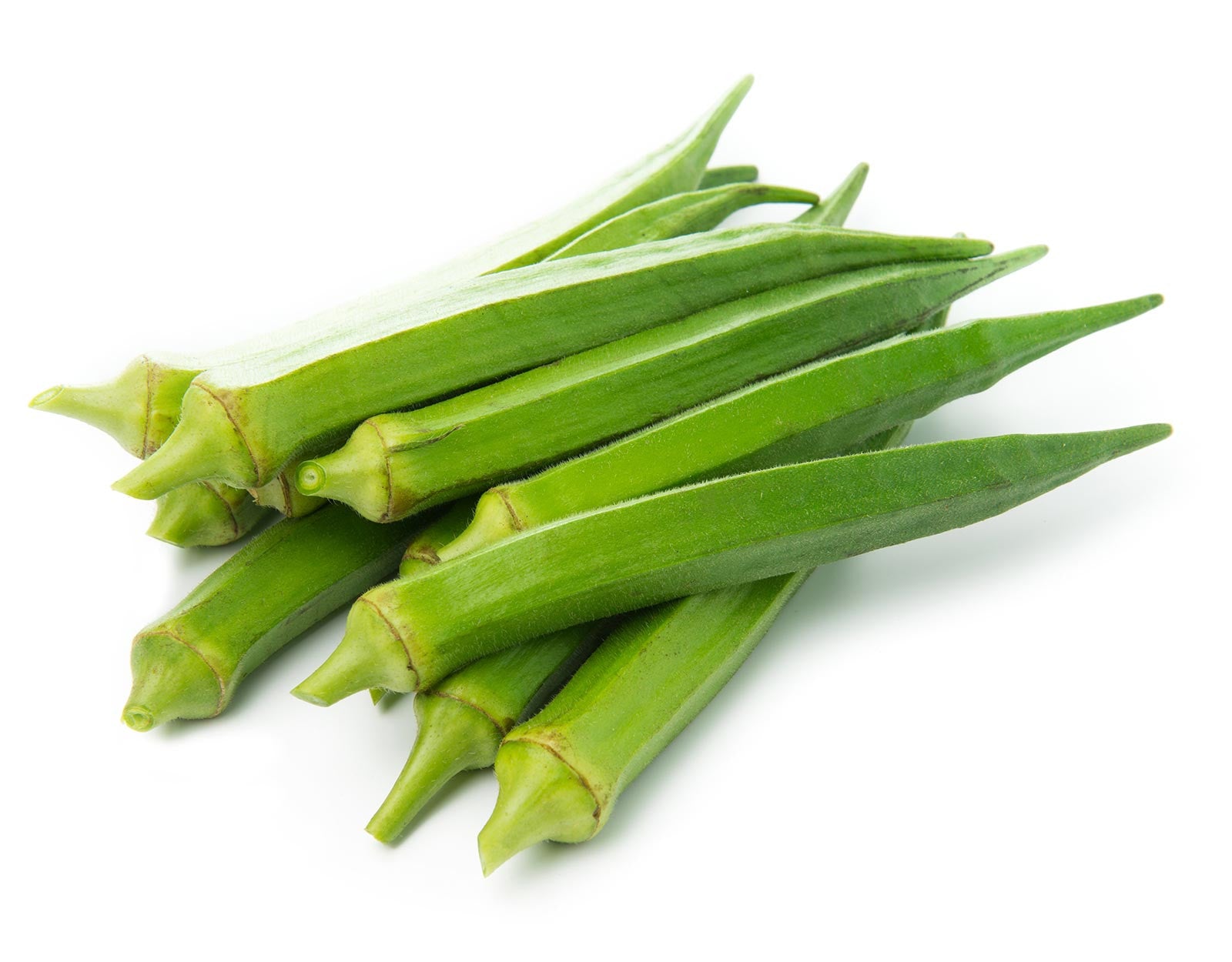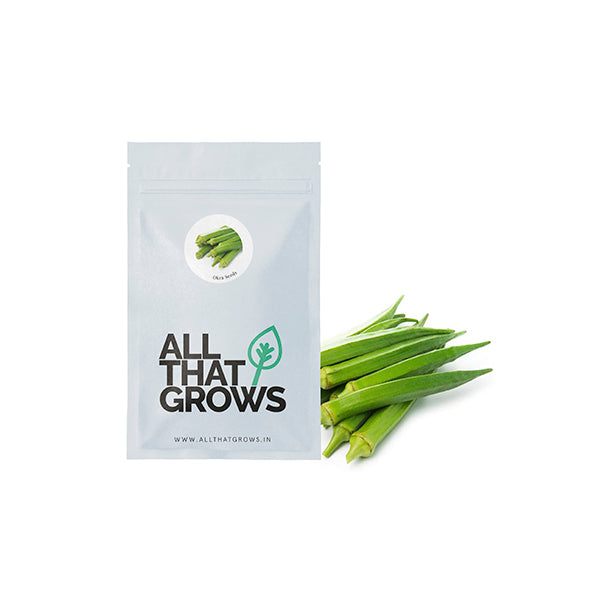



Okra Seeds
Grow this with
Seed Type : Non-Hybrid, Open Pollinated and Non-GMO
Plant type : Plants well branched
Sowing time : January to March (summers) , June to July (rainy season)
Fruit Length : 5-6 inches
Fruit color : Dark green
Specification : Very sleek , thin, 5 ridged, no visibility of grains even at maturity.
Harvesting : After 45-50 days from sowing, heavy yielder, tolerant to virus.
- SOWING
TIMEJan - Mar (summers)
Jun - Jul (rainy season) - Sowing
DistancePlant to plant - 12"
Line to line - 18" - Fruit
WeightN/A
- Fruit
Shapelong with
five ridges - Days to
maturity45-50 days
- Details
- How to sow
- Reviews
First cultivated in Africa, Okra popularly travelled from there to America and South Asia and became a much-loved summer vegetable. Grown usually in tropical and sub-tropical weather conditions, Okra has a gummy texture and belongs to the Malvaceae family of flowering plants. Okra is also one of the most heat and drought resistant vegetable. It is full of life-sustaining nutrients and minerals such as Vitamin A, B6, C, K, dietary fibre, folate, potassium, calcium, magnesium, and iron. Eating Okra, rich in so many health-giving nourishing substances, is a great way to have healthy cholesterol levels, maintain weight, prevent the risk of developing colorectal cancer, have a strong immune system, as well as protect the eyesight and body tissues. Though not in abundance but the ladyfinger does carry small quantities of protein, carbohydrate, and almost negligible calories too. These also have plenty of antioxidants such as beta-carotene, xanthin, and lutein and can also help in keeping the heart healthy and reduces the chances of being afflicted with type 2 diabetes monumentally.
In India, Okra is cooked in a variety of ways. Fried, stuffed, or cooked simply after cutting in equal sized pieces with spices.
Planting instructions
You can sow okra directly in your garden 3 to 4 weeks before springs starts.
Plant okra about ½ to 1 inch deep and 12 to 18 inches asunder.
You can soak the seeds overnight in tepid water to help speed up germination.
Be sure to space them 1 to 2 feet apart to give them ample room to grow. These plants are tall, thus, be sure to space out the rows 3 to 4 feet apart.
Growing Requirements
watering
Although okra is somewhat drought-tolerant, giving the plants about 1 litre of water per week is ideal.
pests
Pest infestation symptoms include brown-black necrotic lesions on leaves which may have chlorotic margins. Small soft bodied insects on underside of leaves and stems of young transplants or seedlings also cause damage. Pests that can affect this plant are Aphids, Corn earworms, Stinkbugs, Fusarium wilt.
soil
Although okra grows best in soil with a pH between 6.5 and 7.0, it can grow in soil with a pH up to 7.6. The soil should be loamy, crumbly and well drained.
spot
Choose the sunniest place in the garden to grow okra.
temperature
The plant can grow above 10 C (50 F ), but to flower and to bear fruit abundantly, the temperature must be around 23-35 C (75 to 95 F) ideally. Okra flourishes in warm conditions, can bear hot climate and fails in cold temperature.
how to harvest
The first harvest will be ready in about 2 months after sowing.
Harvest the okra when it's about 2 to 3 inches long every other day.
Cut the base, just above the cap with a knife. If the shank is also hard to ignore, the cod is probably too old and should be cast aside.
Wear long gloves when cutting the okra because most forms might carry skin irritants, unless you have a spineless variety.
To store okra, put the uncut and uncooked pods into freezer bags and stash away in the deep-freeze.

Customer Reviews
The productiveness of any seed we sell is subject to your local climatic conditions*, the sowing method you adopt, and your commitment to the planting process. We give no warranty, expressed or implied, and are in no way responsible for the produce.
Please note that all our seasonal recommendations/ sowing information is as per the local climatic conditions. *For more information on the optimum conditions required for growing seeds in your region, please contact us at, hello@allthatgrows.in or Whatsapp us at, +91 8544865077
Questions & Answers
Ask a Question-
Does these seeds require any pestisides?
Yes, because it is always good for the growth of your plant, but we recommend to use natural products to apply like this your plant will grow in a healthy way please go through our website and you can the best and natural pesticides.
-
Can I sow okra seeds in a pot?
You can grow any okra variety in a pot, Sow 2-3 okra seeds 1/2 to 1 inch deep in each pot. Water with a sprayer and keep the seeds in a bright, warm place, the substrate should remain moist until seeds germinate. The germination takes 5 to 10 days after sowing.
-
What is ther germination percentage of okra seeds?
Average 75%.
-
How many packets should I buy to grow in 6 normal sized pots for my balcony?
For 6 normal size pots (12 inch diameter) ,one packet should be enough.. sow 3 -4 seeds in every pot and after germination keep only 1 healthy seedling per pot ( do the thinning when seedling are arounf 4 inches in height .
-
Can this grow in indirect sunlight?
Yes.
-
Can this be grown in Kerela?
Yes.
-
Is this organic seed
Hello,
Thanks for writing to us. They are non-hybrid and GMO-free. We do not treat our seeds. Our seeds are not organic. They are pure varieties traditionally produced using open pollination methods.
As for organic seeds, they are very rare to find and are extremely difficult and expensive to produce.
Regards,
Team AllThatGrows -
Is it hybrid seeds
Hi, Thanks for writing to us. All our seeds are non-hybrid, non-GMO open-pollinated heirloom varieties. They are pure varieties traditionally produced using open pollination methods.
Hope this helps.
Regards,
Team AllThatGrows




Okra Seeds
Seed Type : Non-Hybrid, Open Pollinated and Non-GMO
Plant type : Plants well branched
Sowing time : January to March (summers) , June to July (rainy season)
Fruit Length : 5-6 inches
Fruit color : Dark green
Specification : Very sleek , thin, 5 ridged, no visibility of grains even at maturity.
Harvesting : After 45-50 days from sowing, heavy yielder, tolerant to virus.
Grow this with
First cultivated in Africa, Okra popularly travelled from there to America and South Asia and became a much-loved summer vegetable. Grown usually in tropical and sub-tropical weather conditions, Okra has a gummy texture and belongs to the Malvaceae family of flowering plants. Okra is also one of the most heat and drought resistant vegetable. It is full of life-sustaining nutrients and minerals such as Vitamin A, B6, C, K, dietary fibre, folate, potassium, calcium, magnesium, and iron. Eating Okra, rich in so many health-giving nourishing substances, is a great way to have healthy cholesterol levels, maintain weight, prevent the risk of developing colorectal cancer, have a strong immune system, as well as protect the eyesight and body tissues. Though not in abundance but the ladyfinger does carry small quantities of protein, carbohydrate, and almost negligible calories too. These also have plenty of antioxidants such as beta-carotene, xanthin, and lutein and can also help in keeping the heart healthy and reduces the chances of being afflicted with type 2 diabetes monumentally.
In India, Okra is cooked in a variety of ways. Fried, stuffed, or cooked simply after cutting in equal sized pieces with spices.
Seed Type : Non-Hybrid, Open Pollinated and Non-GMO
Plant type : Plants well branched
Sowing time : January to March (summers) , June to July (rainy season)
Fruit Length : 5-6 inches
Fruit color : Dark green
Specification : Very sleek , thin, 5 ridged, no visibility of grains even at maturity.
Harvesting : After 45-50 days from sowing, heavy yielder, tolerant to virus.
- SOWING
TIMEJan - Mar (summers)
Jun - Jul (rainy season) - Sowing
DistancePlant to plant - 12"
Line to line - 18" - Fruit
WeightN/A
- Fruit
Shapelong with
five ridges - Days to
maturity45-50 days
Planting instructions
You can sow okra directly in your garden 3 to 4 weeks before springs starts.
Plant okra about ½ to 1 inch deep and 12 to 18 inches asunder.
You can soak the seeds overnight in tepid water to help speed up germination.
Be sure to space them 1 to 2 feet apart to give them ample room to grow. These plants are tall, thus, be sure to space out the rows 3 to 4 feet apart.
Growing Requirements
watering
Although okra is somewhat drought-tolerant, giving the plants about 1 litre of water per week is ideal.
pests
Pest infestation symptoms include brown-black necrotic lesions on leaves which may have chlorotic margins. Small soft bodied insects on underside of leaves and stems of young transplants or seedlings also cause damage. Pests that can affect this plant are Aphids, Corn earworms, Stinkbugs, Fusarium wilt.
soil
Although okra grows best in soil with a pH between 6.5 and 7.0, it can grow in soil with a pH up to 7.6. The soil should be loamy, crumbly and well drained.
spot
Choose the sunniest place in the garden to grow okra.
temperature
The plant can grow above 10 C (50 F ), but to flower and to bear fruit abundantly, the temperature must be around 23-35 C (75 to 95 F) ideally. Okra flourishes in warm conditions, can bear hot climate and fails in cold temperature.
how to harvest
The first harvest will be ready in about 2 months after sowing.
Harvest the okra when it's about 2 to 3 inches long every other day.
Cut the base, just above the cap with a knife. If the shank is also hard to ignore, the cod is probably too old and should be cast aside.
Wear long gloves when cutting the okra because most forms might carry skin irritants, unless you have a spineless variety.
To store okra, put the uncut and uncooked pods into freezer bags and stash away in the deep-freeze.



 Sign In
Sign In








